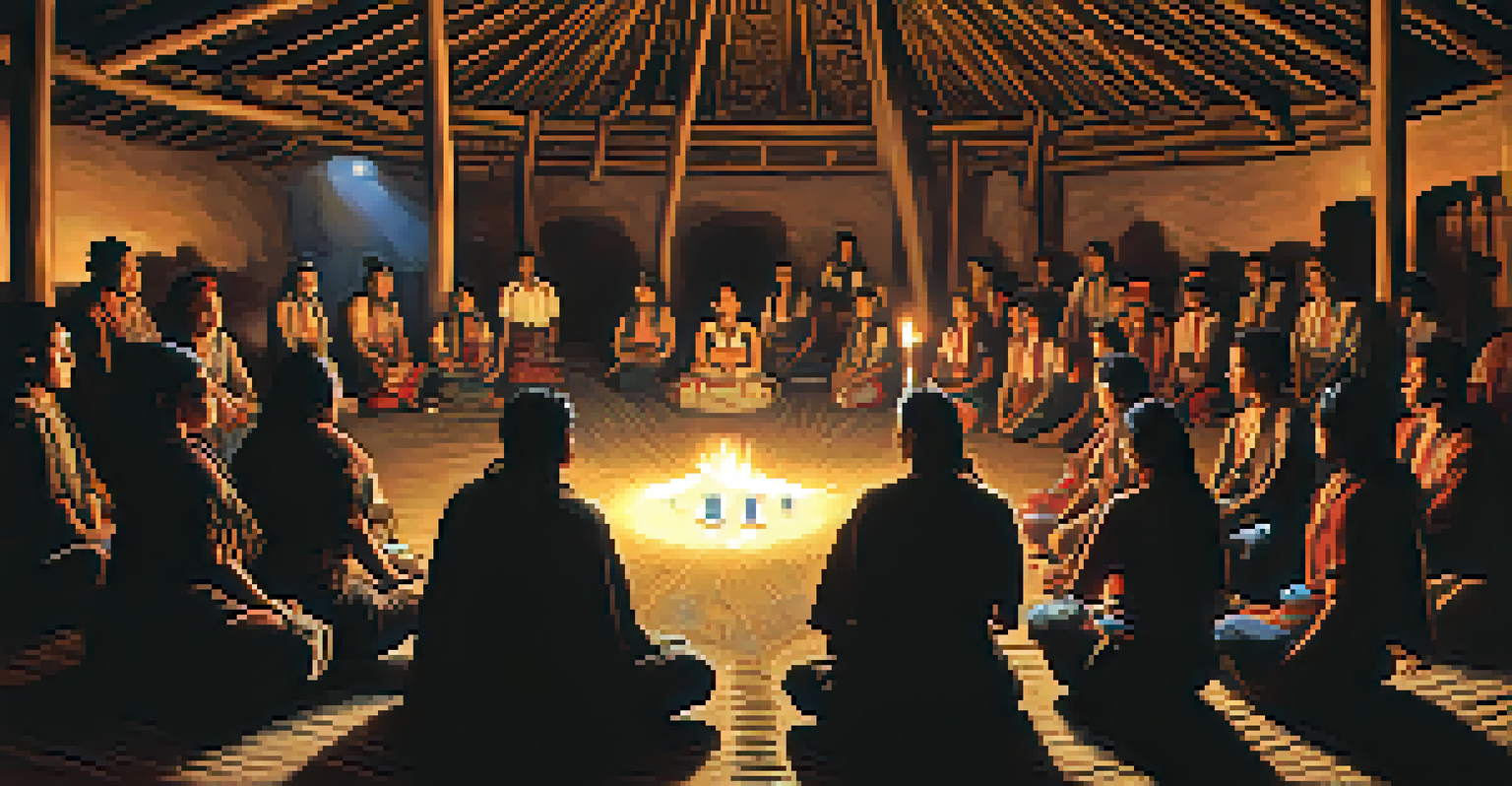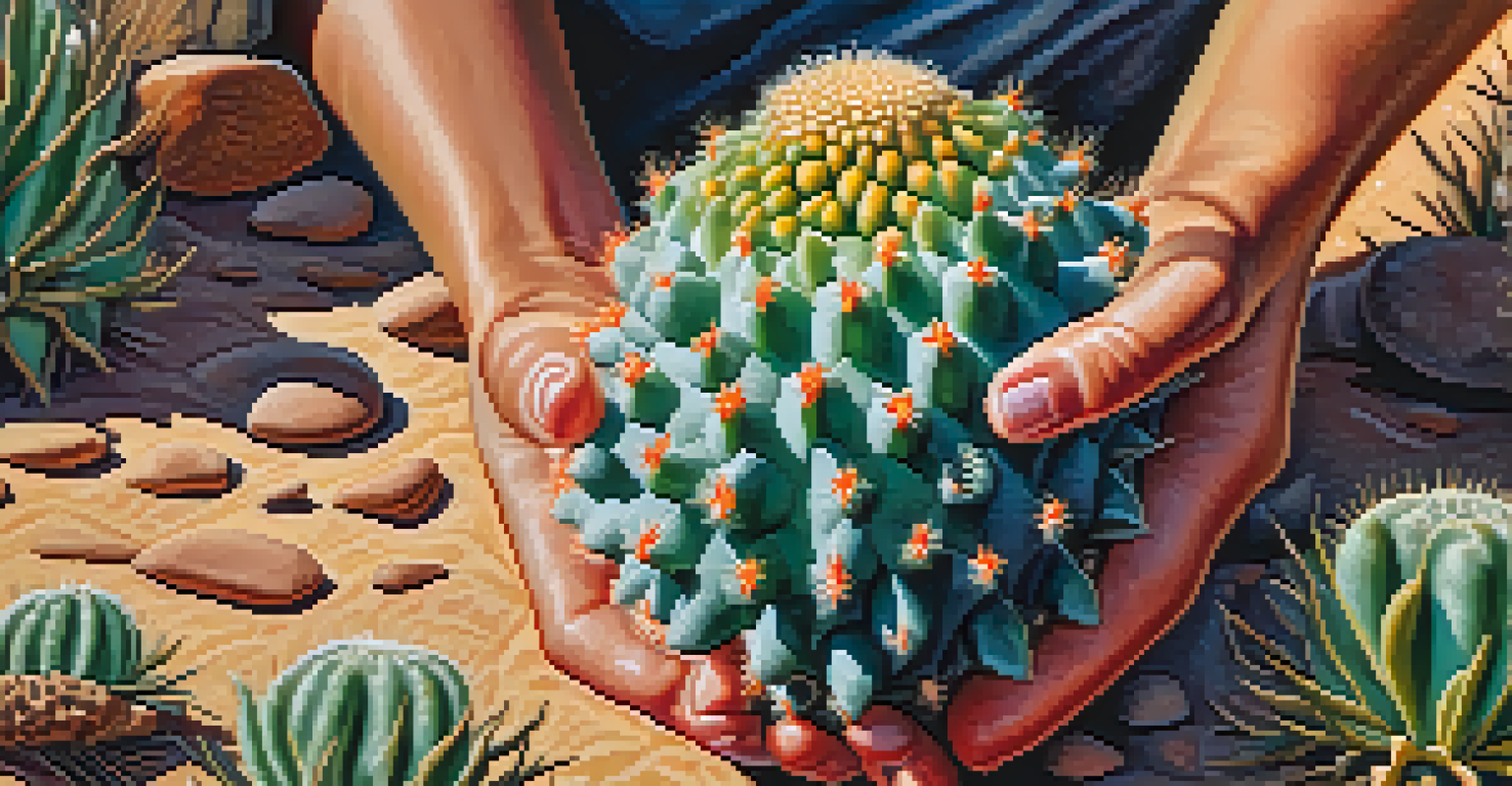Exploring Peyote's Role in Defining Sacred Spaces in Rituals

Understanding Peyote: A Brief Introduction to Its Significance
Peyote is a small, spineless cactus native to Mexico and the southern United States, famous for its psychoactive properties. Traditionally used in various Indigenous cultures, it holds deep spiritual significance, particularly among the Huichol and Navajo tribes. This cactus contains mescaline, which can induce altered states of consciousness, making it a vital element in many rituals.
The use of peyote is a way to connect with ancestors and preserve traditional practices.
In these contexts, peyote is not merely a substance; it embodies a connection to the divine. Participants often consume it during sacred ceremonies, aiming to foster spiritual insight and communal bonding. The cactus serves as a bridge between the physical and spiritual worlds, allowing individuals to explore their inner selves and the cosmos.
Understanding peyote's role is crucial because it highlights how natural elements can define sacred spaces. The reverence for peyote is woven into the cultural fabric of the communities that use it, emphasizing the importance of respecting these traditions and the environments they inhabit.
The Concept of Sacred Spaces in Indigenous Rituals
Sacred spaces are locations imbued with spiritual significance, serving as venues for rituals and communal gatherings. In many Indigenous cultures, these spaces are not only physical locations but also embody a sense of identity and heritage. They are often seen as places where the boundaries between the material and spiritual worlds blur.

These spaces can be natural landscapes, such as mountains or rivers, but they are also created through intentional human activities during rituals. For example, a circle formed by participants can represent unity and connection, enhancing the sacred nature of the gathering. This intentionality transforms ordinary environments into sanctified areas filled with purpose and meaning.
Peyote's Spiritual Significance
Peyote serves as a vital element in Indigenous rituals, promoting spiritual insight and community bonding.
Peyote plays a pivotal role in these rituals, as it often marks the beginning of a journey into the sacred space. By consuming peyote, participants enter a heightened state of awareness, allowing them to engage more fully with the spiritual dimensions of their surroundings.
The Role of Peyote in Enhancing Spiritual Experiences
When consumed in a ceremonial setting, peyote can deepen spiritual experiences and promote introspection. Users often report vivid visual experiences and profound insights during peyote rituals, which can lead to a sense of interconnectedness with nature and the universe. This transformative experience is often described as a journey into the self, revealing layers of consciousness previously unexplored.
Peyote facilitates transformative experiences that connect individuals to their heritage and each other.
Moreover, the communal aspect of these rituals amplifies the effects of peyote. Participants often share their experiences, fostering a sense of belonging and collective understanding. This shared journey can create lasting bonds and reinforce cultural identities, making the ritual an essential part of community life.
In this way, peyote acts as both a catalyst and a guide in spiritual practices, helping individuals navigate their inner landscapes while also linking them to their community and traditions.
Rituals Involving Peyote: A Closer Look
Rituals involving peyote can vary widely among different Indigenous groups, yet they often share common elements. These rituals typically include chanting, drumming, and the sharing of stories, all of which help create a sacred atmosphere. Participants may enter a longhouse or a designated area, marking the transition from everyday life to a sacred experience.
The peyote ceremony often starts with a prayer or invocation, calling upon spiritual guides or ancestors for protection and guidance. This act of calling creates an intentional space where participants can feel safe to explore their spirituality. As the peyote takes effect, the ritual unfolds, often lasting several hours and leading participants through various emotional and spiritual phases.
Cultural Identity and Continuity
The use of peyote rituals helps Indigenous tribes connect with their ancestors and preserve their cultural identity.
By integrating peyote into these rituals, participants can experience a profound shift in perception, allowing them to see their lives and the world from new perspectives. These shared experiences are what define the sacred space, making each ritual unique yet deeply rooted in tradition.
Cultural Significance of Peyote in Defining Identity
Peyote is more than just a plant; it is a symbol of cultural identity for many Indigenous tribes. The use of peyote in rituals is a way to connect with ancestors and preserve traditional practices. It serves as a reminder of the resilience and continuity of Indigenous cultures despite historical challenges.
When communities engage in peyote rituals, they reinforce their shared beliefs and values, crafting a collective identity that transcends generations. This aspect of cultural significance makes peyote rituals vital not only for spiritual exploration but also for cultural preservation.
In a world where Indigenous identities are often marginalized, the reverence for peyote offers a powerful avenue for reclamation and pride. It allows communities to assert their rights to their traditions and sacred practices, fostering a sense of belonging and continuity.
Challenges and Misunderstandings Surrounding Peyote Use
Despite its importance, the use of peyote is often misunderstood and stigmatized. Many people outside of Indigenous cultures may view peyote solely as a recreational drug, overlooking its profound spiritual significance. This misunderstanding can lead to appropriation and misuse, which can be harmful to Indigenous communities.
Legal challenges also surround peyote use, particularly as Indigenous groups strive to protect their rights to practice their traditions. In some regions, peyote is classified under strict drug regulations, making it challenging for Indigenous peoples to access it for ceremonial purposes. This legal landscape can create barriers to maintaining cultural practices.
Challenges of Misunderstanding Peyote
Peyote's sacred role is often misunderstood, leading to stigmatization and legal challenges for Indigenous communities.
Awareness and education about peyote's role in rituals can help bridge this gap, promoting respect for Indigenous practices while fostering a deeper understanding of the cultural contexts in which peyote is used.
Conclusion: The Enduring Legacy of Peyote in Sacred Spaces
Peyote's role in defining sacred spaces and rituals is a testament to its enduring legacy within Indigenous cultures. By serving as a bridge between the physical and spiritual realms, peyote facilitates transformative experiences that connect individuals to their heritage and each other. The rituals surrounding peyote not only honor the plant but also the rich cultural narratives that accompany it.
As we explore the complexities of peyote's significance, it becomes clear that understanding its role is crucial for appreciating the broader context of Indigenous spirituality. By respecting these traditions, we acknowledge the importance of sacred spaces and the practices that define them.

Ultimately, peyote represents a profound connection to identity, community, and spirituality, reminding us of the powerful relationship between people and the natural world.